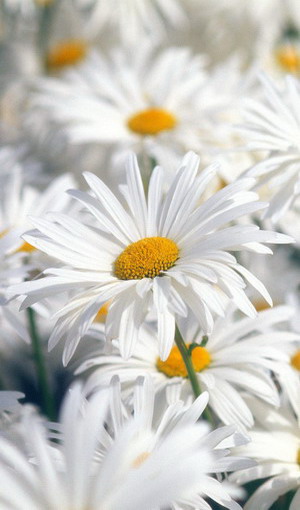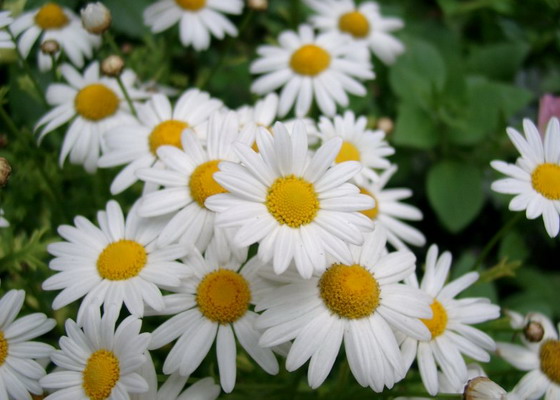
Plant type: herbaceous.
Homeland: Mediterranean, South Africa, countries of the East.
Chamomile – description
They are hardy perennial and annual herbs. They grow from 30 to 60 cm in height and have pubescent foliage. Chamomile is a field flower and can often be found in the wild in meadows and fields.
- Leaf ornament: present. The foliage is smooth, two-pinnate.
- Flowering: on the tops of the stems, clusters of small flowers are formed that resemble daisies. Hue – white, yellow.
- Aroma: The flowers have a sweet, subtle scent.
- Growth rate: fast.
Chamomile – cultivation
Growing environment: greenhouse, garden, home conditions.
Care: if the plants are provided with suitable conditions, they will not need careful care.
Lighting: the location should be sunny, but the flower also tolerates partial shade.
Soil type: sandy, it is desirable that the soil contains lime. The soil must be well drained. If the soil contains few nutrients, then this will not interfere with the good development of daisies.
Watering: Garden chamomile requires regular watering during hot weather, especially if you are growing it in pots.
Fertilizers: Chamomile, which is not so difficult to grow, will grow well if top dressing is applied to the soil directly at the time of planting. In the process of preparing the beds, you can add compost.
Reproduction: carried out by planting seeds in spring or late autumn. Frost is required for best seed germination. When sowing seeds, sprinkle them with a thin layer of soil and water thoroughly. The first shoots will appear within two weeks. The distance between plants should be about 30 cm. For permanent cultivation in the garden, one planting will be enough. The following year, new flowers will appear in the same place.

The white chamomile in the photo is captured in its natural environment
When grown indoors, the seed germination period is one to three weeks. The temperature regime should be in the range of 21-24°C. Planting should be done seven to eight weeks before the expected last frost. Once they have passed, the sprouts can be planted in the garden.
Application: These flowers are great for growing in containers or on balconies. Chamomile, described above, is often used to make decoctions or teas. Dried flowers are used for this purpose. The leaves are edible and have a slightly bitter taste.

The pharmaceutical properties of the flower are known. Decoctions of these plants relieve the pain that occurs with indigestion, and also help in the treatment of dental wounds. If you regularly drink chamomile infusions, then you will improve your immune system and will not be susceptible to colds and other infections. There is also an opinion that a pot of flowers located by the bed contributes to a healthier sleep.
Care Tips and Tricks: These flowers need to be kept under control as they can become weeds due to the production of large amounts of seeds. If there are too many flowering plants in your garden, then cut off the flowers along with the stems and place them in a place so that they dry. Insects that eat the seeds will completely destroy them. If you want the flowering to be even more abundant, you need to remove dead flowers. In autumn, perennial daisies need to be cut right at the soil cover.
Optional: if you choose chamomile for growing at home, then it is better if they do not have flowers, but are covered with lush foliage. Thus, when planting, all the nutrients will be used for the development of the root system. Mulching the soil will have a positive effect.
The following types of this plant are most widely used:
Chamomile meadow – Leucanthemum vulgare
In another way, it is called nivyanik . Belongs to the aster family. This variety is native to Europe and parts of Asia. Its height reaches 60 cm, and it grows by 30 cm in width. Meadow chamomile has unbranched stems that grow from the rhizome. The foliage of this flower is dark green on both sides. The middle leaves are toothed and longer than the upper ones.

Roman chamomile (noble) – Roman chamomile
It is a perennial plant that does not grow taller than 30 cm. Great for covering bare ground in the garden. The leaves of this variety are used as food in the preparation of potato dishes. Propagated by seeds or division of roots.

German chamomile – German chamomile
This is an annual flower , which reaches a height of 50 cm and has fragrant flowers. Plant seeds of this variety should be in early spring in a sunny place. Like white chamomile, this species requires well-drained, sandy soil. Abundant watering is desirable. If the conditions are too dry and hot, then in the middle of the day it is desirable that the plants get a shadow.








